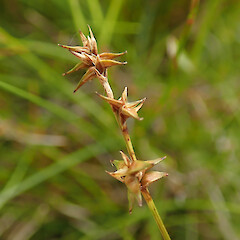Carex echinata
Common name
star sedge
Synonyms
Carex stellulata Good.; Carex stellulata Good. var. australis Kük.
Family
Cyperaceae
Flora category
Vascular – Native
Endemic taxon
No
Endemic genus
No
Endemic family
No
Structural class
Sedges
NVS code
The National Vegetation Survey (NVS) Databank is a physical archive and electronic databank containing records of over 94,000 vegetation survey plots - including data from over 19,000 permanent plots. NVS maintains a standard set of species code abbreviations that correspond to standard scientific plant names from the Ngä Tipu o Aotearoa - New Zealand Plants database.
CARECH
Chromosome number
2n = c.58
Current conservation status
The conservation status of all known New Zealand vascular plant taxa at the rank of species and below were reassessed in 2017 using the New Zealand Threat Classification System (NZTCS) – more information about this can be found on the NZTCS website. This report includes a statistical summary and brief notes on changes since 2012 and replaces all previous NZTCS lists for vascular plants.
Please note, threat classifications are often suggested by authors when publications fall between NZTCS assessment periods – an interim threat classification status has not been assessed by the NZTCS panel.
- Conservation status of New Zealand indigenous vascular plants, 2017 . 2018. Peter J. de Lange, Jeremy R. Rolfe, John W. Barkla, Shannel P. Courtney, Paul D. Champion, Leon R. Perrie, Sarah M. Beadel, Kerry A. Ford, Ilse Breitwieser, Ines Schönberger, Rowan Hindmarsh-Walls, Peter B. Heenan and Kate Ladley. Department of Conservation. Source: NZTCS and licensed by DOC for reuse under the Creative Commons Attribution 4.0 International licence.
2017 | Not Threatened | Qualifiers: SO
Previous conservation statuses
2012 | Not Threatened
2009 | Not Threatened
2004 | Not Threatened
Distribution
Indigenous. New Zealand: North, South and South Islands from about Te Moehau south. Apparently absent from Marlborough.
Habitat
Coastal to alpine (though mainly montane to alpine in northern part of range). Common in wetlands such as bogs and mires or on stream banks and around tarn margins. Descending to sea level in the south-west of the South Island and on Stewart Island.
Wetland plant indicator status rating
Information derived from the revised national wetland plant list prepared to assist councils in delineating and monitoring wetlands (Clarkson et al., 2021 Manaaki Whenua – Landcare Research Contract Report LC3975 for Hawke’s Bay Regional Council). The national plant list categorises plants by the extent to which they are found in wetlands and not ‘drylands’. The indicator status ratings are OBL (obligate wetland), FACW (facultative wetland), FAC (facultative), FACU (facultative upland), and UPL (obligate upland). If you have suggestions for the Wetland Indicator Status Rating, please contact: [Enable JavaScript to view protected content]
OBL: Obligate Wetland
Almost always is a hydrophyte, rarely in uplands (non-wetlands).
Detailed description
Loosely tufted from an ascending rhizome; tufts ± flaccid. Culms 35–350 × c. 0.5 mm, subtrigonous, glabrous; basal sheaths grey or light brown. Leaves usually < culms, 0.5–1.5 mm wide, channelled to flat, margins scabrid, tapering towards the subacute tip. Inflorescence a compound spike 15–40 mm long, green or pale brown, of 3–5 ± distant spikes, utricles widely spreading when ripe and individual spikes star-shaped; lowest spike usually subtended by a filiform scabrid bract c. ½ length of inflorescence. Spikes androgynous, 3–7 mm long, male flowers at the base of each spike; plants occasionally almost dioecious. Glume c. ½ length of utricle, membranous, light brown, with a pale cream or green well-marked midrib and hyaline margins. Utricles 2.5–4.0 × c. 1.5 mm, plano-convex, usually distinctly nerved; contracted above to a narrow, dark brown beak with green, slightly or distinctly scabrid margins and slightly bifid orifice; puckered below to a rather indistinct stipe c. 2 mm long. Stigmas 2. Nut slightly < 2 mm long, ± biconvex, oblong-ovoid, pale brown.
Similar taxa
A distinctive species that is easily recognised by the star-shaped arrangement of the mature spreading utricles. This is clearly seen when the plants are viewed from above. Carex echinata has no obvious close relatives in New Zealand and is unlikely to be confused with any of the introduced or indigenous species known from this country.
Flowering
October–December
Fruiting
November–July (often present throughout the year)
Life cycle
Nuts surrounded by inflated utricles are dispersed by granivory and wind (Thorsen et al., 2009).
Propagation technique
Easy from fresh seed and the division of whole plants. Prefers moist soils, with a sunny aspect, free from weeds.
Etymology
carex: Latin name for a species of sedge, now applied to the whole group.
echinata: From the Latin ‘echinus’ for hedgehog, meaning armed with spines.
Where To Buy
Not commercially available.
Attribution
Fact Sheet prepared by P.J. de Lange (10 August 2006). Description adapted from Moore and Edgar (1970)
References and further reading
Moore LB, Edgar E. 1970. Flora of New Zealand, Volume II. Indigenous Tracheophyta: Monocotyledones except Gramineae. Government Printer, Wellington, NZ. 354 p.
Thorsen MJ, Dickinson KJM, Seddon PJ. 2009. Seed dispersal systems in the New Zealand flora. Perspectives in Plant Ecology, Evolution and Systematics 11: 285–309.
NZPCN Fact Sheet citation
Please cite as: de Lange, P.J. (Year at time of access): Carex echinata Fact Sheet (content continuously updated). New Zealand Plant Conservation Network. https://www.nzpcn.org.nz/flora/species/carex-echinata/ (Date website was queried)











